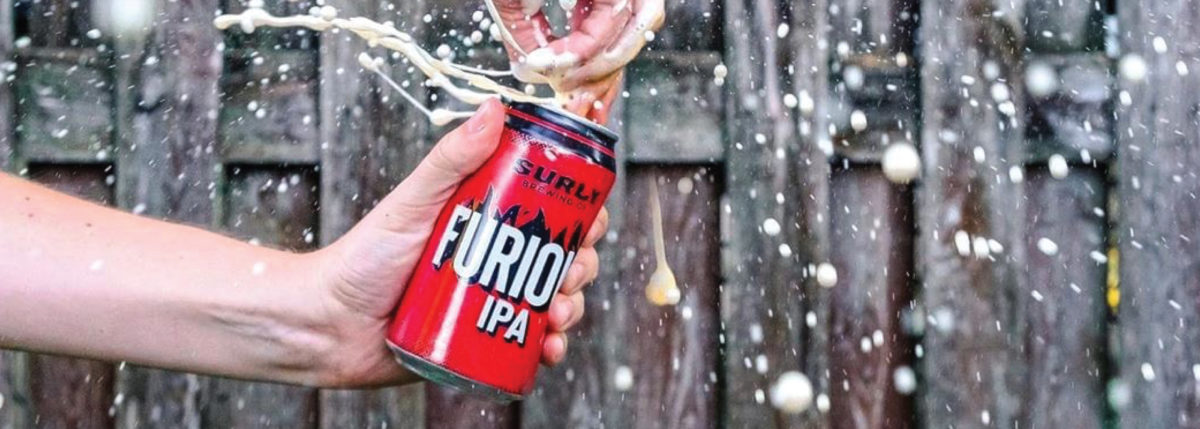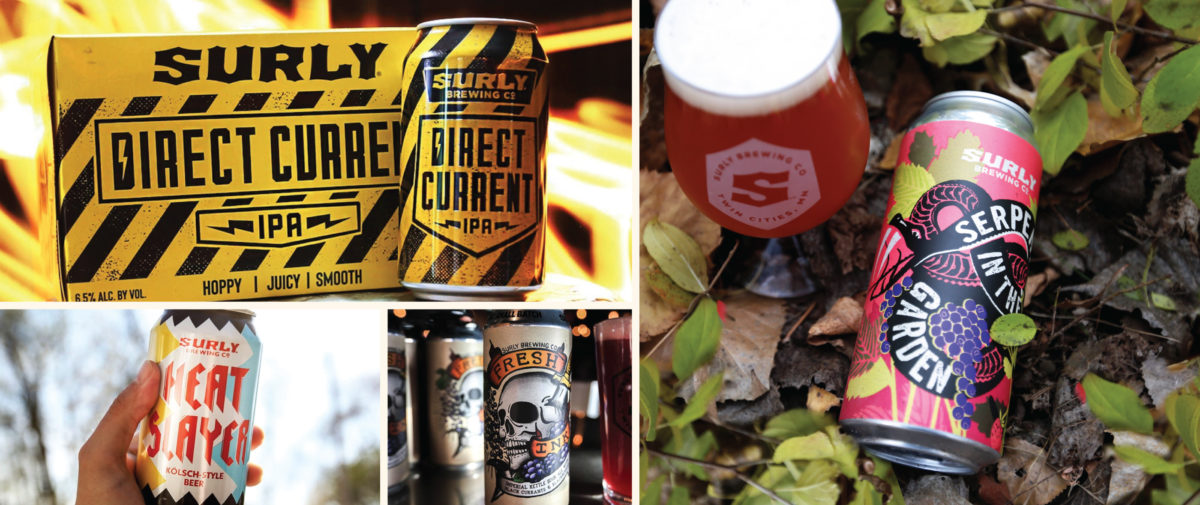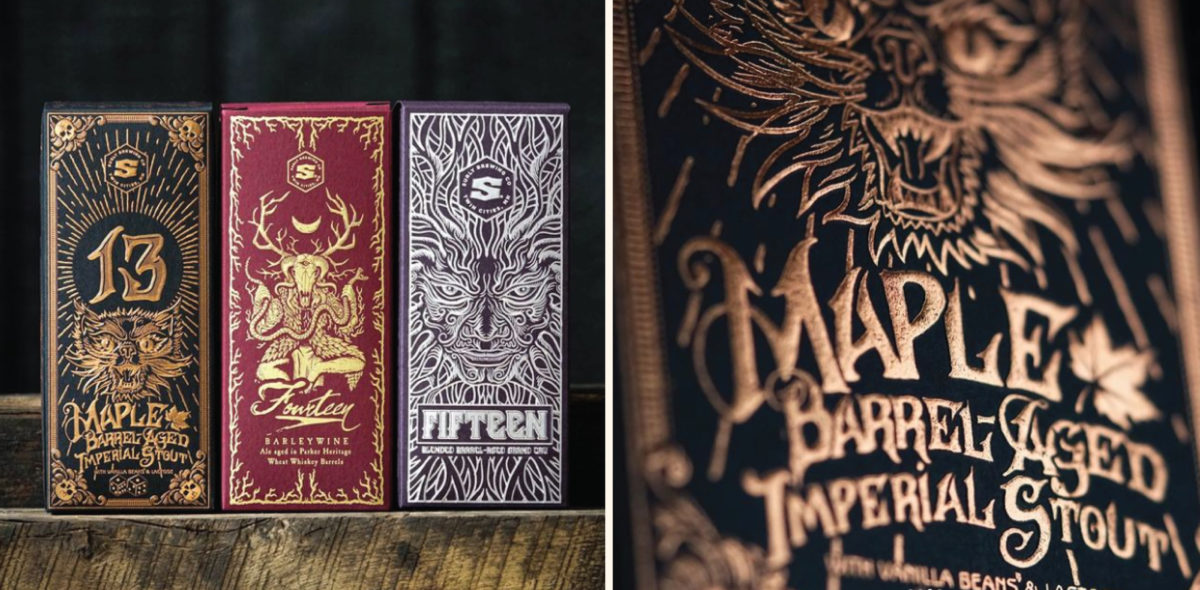Resources
In-House with Surly Brewing
Variety Packs, Small Batch Programs & Sub-Brand Development
Minnesota’s Surly Brewing is one of the largest craft breweries in the United States. Their growth has been driven by a few fantastic flagship brands, Darkness (a hype-worthy limited release stout) and iconic, brash branding.
We sat down with Bill Manley, VP of Marketing and Brand, at Surly Brewing to discuss the day-to-day runnings of their branding and packaging. And we got to dive into a few topics that smaller breweries might find valuable, including using variety packs to drive trial, the role of a small batch release program as offering a “point of view” for your brand, and Brand Architecture in general and sub-brand development in particular.
Let’s dive in.


Hi, Bill. Please introduce yourself and tell us what you do at Surly Brewing.
 Bill
Bill
Hi there, I’m Bill Manley and I’m the VP of Marketing and Brand at Surly Brewing Co. in Minneapolis, MN.

Can you give us a rundown on Surly Brewing—founding date, annual production (bbls), distribution footprint, well-known beers, etc?
 Bill
Bill
Surly was founded in 2006 by Omar Ansari, the son of immigrants, who started the brewery in the corner of his parents abrasives factory in Brooklyn Center, MN. The brewery took off, and eventually replaced the abrasives factory as the family business. In 2014, Surly opened its Destination Brewery in Minneapolis which is the main production facility, and houses a large restaurant, event center, beer garden, pizza concept and festival concert venue.
Post-COVID, Surly’s annual production is about 78,000 Barrels, and currently distributed to 14 states, although Minnesota makes-up the lion’s share of the business at about 80% of the total volume.
Well-known beers are Furious IPA (Surly’s flagship) Axe Man IPA, Abrasive Double IPA and Darkness Russian Imperial Stout among others.

What does your creative team look like? How many folks, roles, etc?
 Bill
Bill
Right now, our creative team is made-up of three in-house designers. I act as the brand director and the de facto art director. We regularly work with outside artists on special projects, but the bulk of our design is generated in-house.

What was Minnesota missing when Surly open up shop?
 Bill
Bill
So the story goes that Surly is surly due to the inability to find a good beer. Of course, there were breweries in the state prior to Surly, but these were older more traditional brewers. There was nobody making the big and aggressive beers that Omar was searching for. Surly quickly gained a reputation as a bold and brash brewery bringing the first Double IPA, the first big Imperial Stout and the first sour beers to Minnesota.


Build a stronger brand.
Sell more beer.
Join 7,500+ other beer industry folks and sign up for our monthly Beer Branding Trends Newsletter.

Beer Branding Trends 2.0

I’d like to dive into the BC Small Batch program for a bit. Can you give me a quick overview?
 Bill
Bill
The BC Small Batch series is a rotating program of specialty beers released throughout the year. Named after our original Brooklyn Center brewery where the beers are still brewed. These beers are in a 4-pack 16-ounce format and feature experimental recipes, collaborations, and fun and creative beers that keep things exciting for the brewers, designers, sales team, and our consumers.

How many barrels do you produce through the BC Small Batch program per year? And how important is this program to your overall business? I know Surly is diversified with flagships and taprooms—does BC move serious beer for you or is it more of a thing to keep your community excited about Surly (and keep your brewery team creatively engaged)?
 Bill
Bill
We release BC Small in an ad hoc (mostly) bi-monthly program and expect to do between 1,000-1,200 barrels of beer annually. A small portion of our overall production, but an important part of our portfolio.
In terms of overall volume BC Small Batch is only a small part, but in terms of importance to the brewery and the brand, the small batch program is extremely important.
A few years back, we went through a comprehensive brand redesign. We systematized our major-market packages to block better on the shelf and to better inform our fans what they were getting, and to set the best expectations for the beer in the market.
The side effect of having a strong a systematized presence in the off-premise is that we lose some of the flexibility and nimbleness that our fan base is looking for. Having a product segment vehicle like the small batch series lets us stretch our legs a little outside of major-market beer releases and allows us to take chances from both a beer development standpoint and a design perspective.


Do you think a brewery the size of Surly can survive on flagships alone our do you have to have a small batch / limited release program to stay relevant?
 Bill
Bill
Yes, I think it is very important to have a creative outlet for beer and also to use the small batch platform to showcase a point of view for your brand.
Right now, the craft beer market is in a tough place. The gulf between the largest craft brewers and the smaller players is wide and getting wider. Shelf space and cooler space are becoming harder and harder to maintain, and mainline wide-release products have to be stronger than ever to get buy-in from distributors and retailers and allow for fewer risks, from a branding an flavor perspective.
Additionally, here in Minnesota, we have some tough laws to work around.
Surly is one of only five breweries in the entire country that can’t sell any “to-go” beer to our customers. We are prohibited from selling growlers / crowlers or any packaged beers directly to our fans.
Because we don’t have the advantages of direct distribution or “own-premise” package sales, we have to find ways of getting small releases into the larger trade. The BC Small Batch program is our way of getting those smaller, more experimental beers out into the market.
I joke about finding the craft beer parallel with the movie business. Everybody wants to be both a “critical darling and a box office success.” For us, the small fun collaborations, and experimental beers we do as part of the BC Small Batch would never and could never be large, volume-driven releases, but they are important to keep our fans excited and fired-up for the next beer in the series, which ultimately drives more eyes to the brand.

We’re seeing a major trend for legacy breweries to spin off best sellers into fully-fledged sub brands, complete with line extensions, merch and even more of a lifestyle brand positioning—think New Belgium’s Voodoo Ranger, Sierra Nevada’s Little Thing line or Stone’s Arrogant Bastard line. Is this strategy on the table for any of Surly’s brands (maybe the Supreme line)?
 Bill
Bill
You nailed it. Ever since we launched Grapefruit Supreme, our easy-drinking low ABV grapefruit tart ale in the Summer of 2019, that brand has been a major success for us. This past year we launched a Supreme Variety Pack with several variations of low ABV fruited tart beers. Next year, we will debut a second Supreme Variety Pack focusing on tropical fruit variations of the brand.
This past summer, the Supreme brand family climbed into our #2 product spot, and we’re hopeful we can maintain that success heading into next year.
We decided early-on that we didn’t want to make a seltzer. The idea of hard seltzer felt off from a branding perspective, but it’s hard to deny that the flavor promise of those drinks is appealing to people. We thought, “okay, if not seltzer then what can we do that appeals to those flavors, but still feels right for the brand?”
The result was the Supreme line. Essentially, they are low-abv Berliner Weisse-style beers with tradition and heritage that we amped-up with fruit additions. They are light, crisp, and easy to drink but still have a sense of place in our portfolio. We called them Supreme (which was originally meant to be a play on the citrus Suprême cutting technique) but the Supreme idea gave them a little bit of swagger which felt more naturally Surly from a brand execution standpoint.

Surly puts out a lot of different variety packs. Can you tell me about this strategy from a portfolio perspective? (And on a scale of 1 to 10, how much does your brewing/packaging team hate you for this approach?)
 Bill
Bill
Come on now!
Technically we only have two Variety Packs (mainline VP, and Supreme VP) but the mainline pack rotates quarterly (four different configurations per year sharing a single UPC), and we ARE adding another next year, so yeah, I guess we do have a lot.
From a strategy perspective, going back to what I mentioned before, year-round large volume releases have to be tighter than ever before to warrant the shelf space and effort from our partners. Having a brand that is a proven success and that has built-up some equity is a HUGE benefit when those brands graduate from a single one-time release up to a year-round position. The variety packs help us launch brands in a lower-stakes way (consumer typically buy the packs, not the brands) and have a large upside benefit when those brands go to market in a larger way. We’ve had several successful seasonal come out of the variety pack trials, as well as a year-round beer.
Additionally, they seem to be working for us. The variety pack SKU has been either our #2 or #3 brand each year since they launched in 2018.
As far as production hating me… Production has many reasons to hate me on a daily basis, but I honestly don’t think variety packs are the reason. Yes, they are labor intensive. Yes the packaging SKU management is a pain-in-the-ass, but ultimately, they understand that variety packs are important for the brand, and have done an incredible job making them happen.


How have you guys weathered the pandemic?
 Bill
Bill
Strikes and Gutters.
Pre-pandemic we had a heavy draft beer skew (about 40% of our total business was on-premise) so that took a major toll on volume in 2020 and continues to drag down the numbers in 2021. Restaurant and bar business in Minnesota has been slow to recover, and right now, we’re only doing about 30% of the draft business we did in 2019 which of course, hurts the bottom line.
On the flip side, we had a great year for packaged beer last year, and the off-premise continues to be strong. Furious, our flagship beer grew about 35% in 2020, and we’re just about flat on the package side this year despite SUPER tough comps. Draft, though, has us down about 10% year-over-year.

Do you have any book / podcast / newsletter recommendations that beer industry folks should check out?
 Bill
Bill
I listen to A LOT of podcasts, so that’s my jam. For recommendations, I like to look outside the industry for insights that can be applied to it. I’m a big fan of NPR’s Planet Money and the Indicator podcast. I’ve been enjoying the Wisdom from the Top podcast, and I really like 99% Invisible for how design effects the way people live.
For industry-specific news, Mark Brown the CEO of Sazerac Company, compiles a daily “Industry News Update” that gathers BevAlc related news about wine, spirits, beer, “beyond beer,” CBD and other related topics. I read it while I’m eating breakfast and there’s always something that gets me thinking. A great way to start the day.

What project are you most proud of so far?
 Bill
Bill
I’m proud of a lot of the things we’ve been able to do here at Surly, but one of the things I’m most proud of is a packaging piece.
In 2019, we introduced the 16-ounce can-in-box format. We partnered with a local letterpress firm to make ultra-lux foil and embossed single boxes for high-end specialty releases, and the format has helped solve a lot of package problems.
The 750mL market is in shambles. Go to any craft beer store and you’ll find a museum of high-end big bottle formats lining the shelves. The portion size is too big, and the price points are too high. These incredible prestige beers are left to die on shelves.
For us at Surly, we’ve always been a can specific brewery. The only products we made in bottles were our Darkness releases and occasional anniversary beers. We were using a very inefficient and frankly, pretty janky Meheen bottle filler with so-so quality for some of our highest-profile brands instead of our highly-tuned can fillers that we’ve spent years tweaking to meet a “best-in-the-industry” standard. So, we switched to cans.
For our 13th Anniversary, we debuted the format. Single 16-ounce cans of Maple Barrel-Aged Imperial Stout with Vanilla and Lactose with a matte sleeve finish in a highly decorative box. Since then, we’ve released 13 every year on Friday the 13th, and added our other anniversary beers, and Darkness Barrel-Aged variants. This 2021 release of Darkness will be the last bottles we do, as everything “formerly big-bottle” will switch over in 2022.

What’s next for Surly? What are you excited about as we head into 2022 (and beyond)?
 Bill
Bill
I’m cautiously optimistic to round-the-bend into 2022.
As I mentioned earlier, we’ve had a slow year in the on-premise, but as we’ve pushed through summer, those numbers are starting to improve. Winter is always tough in Minnesota, but when the weather even hints at warming-up in the spring beer sales surge. I’m confident that once the ground begins to thaw next spring, we’ll be closer to where we need to be in the on-premise.
Additionally, we have some exciting things in the works that I’m not yet at liberty to discuss just yet, but I think will signal a big change for us in the coming months.

Thanks so much for your time, Bill. This has been great.
 Bill
Bill
Thank you! It’s an honor to be asked to contribute. The CODO blog is a must read for me, and I’m just happy to be here!


Build a stronger brand.
Sell more beer.
Join 7,500+ other beer industry folks and sign up for our monthly Beer Branding Trends Newsletter.
